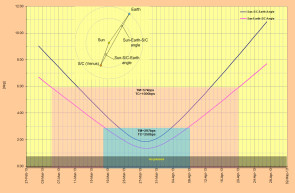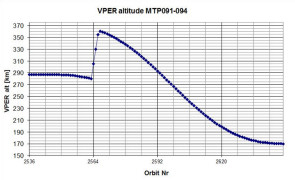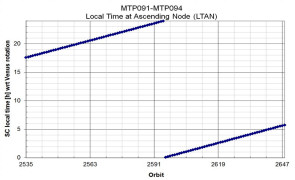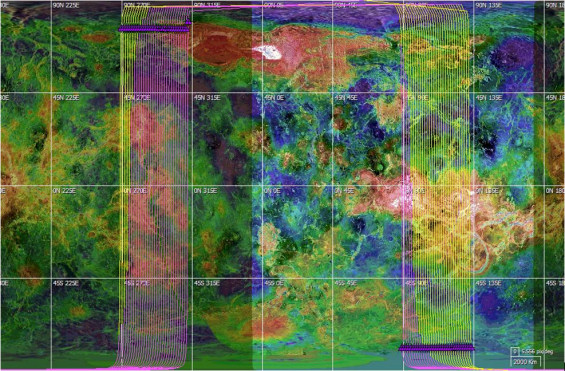No. 259 - End of superior conjunction and resumption of science operations; automation of spacecraft passes at the Mission Operations Centre; thermal fuel gauging tests
Cebreros ground station
All Cebreros ground station activities were nominal during this reporting period.
The telemetry rate was too low to allow science data downlinks during superior conjunction (16 to 24 March). With the Sun almost in the line-of-sight of the spacecraft between 16 March and 8 April, the link budgets were too low to allow any more than a few minutes of daily contact to verify spacecraft health and uplink a few commands if needed. Within that period, from 25 March to 31 March, no contact of any kind was possible with the spacecraft. There were no negative incidents on the ground or the spacecraft during the planned shutdown, and communication activities were nominal.
On 9 April, regular full contact with the Cebreros ground station was resumed, and the spacecraft was reconfigured for nominal operations as the Sun moved far enough out of the line-of-sight of the spacecraft. Science operations resumed on 13 April.
High accuracy spacecraft ranging
The New Norcia and Cebreros ground stations were used for a Delta Differential One-way Ranging (delta-DOR, or DDOR) measurement at the beginning of the Cebreros communications pass on 25 April 2013. The measurements slightly reduced the length of the Cebreros pass and hence the volume of data downloaded during the pass.
These high accuracy ranging measurements are carried out with the Venus Express spacecraft on a regular basis to support the accurate determination of the ephemeris for the planet Venus that is maintained by NASA's Solar System Dynamics Group.
For more information about DDOR, see "Delta-DOR measurements".
Exit from planned superior conjunction shutdown
 |
| Change in angles between the Sun, Earth and Venus Express around the time of superior conjunction. Credit: ESA |
The Sun-Earth-Spacecraft geometry approached solar conjunction with an angle of 3.2 degrees on 16 March, bringing the Sun almost directly between Earth and the spacecraft. This date marked the formal entry to the conjunction operations period. At this time, the quality of the communications signal was such that it was acceptable only at very low data rates, too low for nominal command uplinks or science data downlinks. The downlink telemetry bit rate was reduced to 298 bits per second, and the telecommand uplink bit rate was changed to 150 bits per second.
Some science observations continued, but were limited by the fact that the data could not be downloaded. The fill state of the on-board memory was planned carefully, considering the limited storage space on board, to ensure that no data was overwritten by subsequent observations.
From 25 March through 13 April, there were no communications or telemetry checks with the spacecraft as per plan, because the Sun was directly in the line-of-sight from Earth. During routine operations, the spacecraft is typically left in an Earth-pointing orientation when not actively pointing to obtain science data. During this superior conjunction period however, Earth pointing also meant pointing directly at the Sun. Thus, to minimise unnecessary heating of the main antenna and the feed horns electronics, the spacecraft was pointed 10 degrees away from Earth during this period.
By 13 April, the Sun-Earth-spacecraft geometry allowed the spacecraft to end the communications shutdown forced by the conjunction. Acceptable communications signal quality could, at first, only be achieved at very low data rates – too low for nominal command uplinks or science data downlinks. On 14 April, the data rate was increased and nominal science operations resumed.
Automating spacecraft passes at the Mission Operations Centre
Technology is allowing increased efficiency in many areas, and one of those areas is spacecraft operations at ESA's European Space Operations Centre (ESOC) in Darmstadt, Germany. The Venus Express mission is now phasing in the operation of new software that allows the automation of routine daily contact with the spacecraft. A single spacecraft controller can then oversee communications with multiple spacecraft, with human intervention only required if the spacecraft response differs from expected behaviour.
These automated passes began on 16 April 2013, and tests will continue until the software and the various supporting processes have been certified.
Thermal fuel gauging tests
The fuel on Venus Express is slowly running out. At the present rate of use, it is expected to last until about January 2015. Without fuel, the solar pressure on the spacecraft would eventually change the orbit enough for the spacecraft to dip into the atmosphere at pericentre. After a few such dips, the spacecraft orbit would quickly degrade and Venus Express would plunge and burn up in the Venusian atmosphere.
Determining the exact amount of fuel on board is difficult on any spacecraft. In the absence of gravity, the fuel and oxidizer float around in their tanks. Mesh screens placed over the intake ports help use surface tension to maintain blobs of fuel near the inlet pipes that lead the fuel to the engines.
A method of bookkeeping is used, where the fuel and oxidizer amounts planned to be used for each manoeuvre are recorded and a running tally of the expected fuel and oxidizer levels is maintained. This method provides an estimate; more exact methods are not available.
Engineers at Venus Express's manufacturer, Astrium, have developed a method that may allow the actual fuel level of a spacecraft in orbit to be determined. This method was tested on-board the spacecraft using fuel gauging tests. Due to the planned science shutdown, superior conjunction was a good opportunity for these tests. The first gauging test was conducted on 10 April, and the second on 27 April.
A number of these gauging tests will be conducted over the next few months, when time can be spared. The early tests will be used to obtain calibration data on various sensors; later tests will obtain the actual data. The fuel and oxidizer levels from the new tests will be used in conjunction with data from the old bookkeeping method, to help determine end of life for Venus Express.
Orbit correction manoeuvres
One orbit correction manoeuvre was executed during this reporting period with a burn on 21 April at pericentre to raise the apocentre altitude.
Summary of main activities
The table below shows a chronology of the main spacecraft bus activities in the reporting period.
| Main activities during reporting period | |||
| CEB = Cebreros; DDOR = Delta Differential One-way Ranging; DOY = Day of year; MET = Mission elapsed time; NNO = New Norcia; OCM = Orbit Correction Manoeuvre | |||
|
MET (Day) |
Date | DOY | Main Activity |
| 2700 | 31-Mar-2013 | 90 | Shortened CEB communications pass. |
| 2701 | 01-Apr-2013 | 91 | Shortened CEB communications pass. |
| 2702 | 02-Apr-2013 | 92 | Shortened CEB communications pass. |
| 2703 | 03-Apr-2013 | 93 | Shortened CEB communications pass. |
| 2704 | 04-Apr-2013 | 94 | Shortened CEB communications pass. |
| 2705 | 05-Apr-2013 | 95 | Shortened CEB communications pass. |
| 2706 | 06-Apr-2013 | 96 | Shortened CEB communications pass. |
| 2707 | 07-Apr-2013 | 97 | Shortened CEB communications pass. |
| 2708 | 08-Apr-2013 | 98 | Shortened CEB communications pass. |
| 2709 | 09-Apr-2013 | 99 | CEB communications pass. |
| 2710 | 10-Apr-2013 | 100 | CEB communications pass. Thermal fuel gauging test. |
| 2711 | 11-Apr-2013 | 101 | CEB communications pass. |
| 2712 | 12-Apr-2013 | 102 | CEB communications pass. |
| 2713 | 13-Apr-2013 | 103 | CEB communications pass. |
| 2714 | 14-Apr-2013 | 104 | CEB communications pass; restart of science observations. |
| 2715 | 15-Apr-2013 | 105 | CEB communications pass. |
| 2716 | 16-Apr-2013 | 106 | Automated CEB communications pass. |
| 2717 | 17-Apr-2013 | 107 | Automated CEB communications pass. |
| 2718 | 18-Apr-2013 | 108 | Automated CEB communications pass. |
| 2719 | 19-Apr-2013 | 109 | CEB communications pass. |
| 2720 | 20-Apr-2013 | 110 | CEB communications pass. |
| 2721 | 21-Apr-2013 | 111 | CEB communications pass; OCM at pericentre. |
| 2722 | 22-Apr-2013 | 112 | CEB communications pass. |
| 2723 | 23-Apr-2013 | 113 | Automated CEB communications pass. |
| 2724 | 24-Apr-2013 | 114 | Automated CEB communications pass. |
| 2725 | 25-Apr-2013 | 115 | DDOR with NNO/CEB. Automated CEB communications pass. |
| 2726 | 26-Apr-2013 | 116 | Automated CEB communications pass. |
| 2727 | 27-Apr-2013 | 117 | CEB communications pass. Thermal fuel gauging test. |
At the end of the reporting period on 27 April, Venus Express was at 255 million km from Earth. The one-way signal travel time was 851 seconds. The final oxidizer mass was 18.997 kg and the final fuel mass was 11.630 kg
Scientific focus
This reporting period falls under the 91st Medium Term Plan (MTP), which covered the period from 31 March 2013 through 27 April 2013. With the end of superior conjunction on 13 April, Venus Express's planned communications outage with Earth came to an end.
No eclipse or occultation observations were performed during this reporting period.
The MTP started with near-terminator orbits, which typically present an opportunity to perform drag measurements as the spacecraft touches the outer reaches of the atmosphere. However, no drag measurements were conducted during this reporting period due to superior conjunction.
This provided an opportunity for the SPICAV (Spectroscopy for Investigation of Characteristics of the Atmosphere of Venus) instrument to perform stellar occultation observations. Data were obtained to study the variation of the density of the middle atmosphere during night time as a function of distance from the terminator. This involved a series of stellar occultations using the same star in consecutive orbits after exiting superior conjunction.
Following this stellar occultation campaign, night-side observations were devoted to the nitrous oxide (NO) observation campaign. This campaign will continue beyond this reporting period. Half of all orbits were assigned to this NO campaign.
On the dayside, cloud-tracking observations using the Venus Monitoring Camera (VMC) were prioritised.
Payload activities
The science instruments performed nominally, as usual. The instruments were not operated during the science operations shutdown discussed above.
| ASPERA | The instrument was regularly operated nominally as part of the routine plan. |
| MAG | The instrument was regularly operated nominally as part of the routine plan. |
| PFS | The instrument was not operated. |
| SPICAV | The instrument was regularly operated nominally as part of the routine plan. |
| VMC | The instrument was regularly operated nominally as part of the routine plan. |
| VeRa | The instrument was not operated, as there were no Earth occultation observations. |
| VIRTIS | The instrument was regularly operated nominally as part of the routine plan. |
Future milestones
- Start of the fifteenth eclipse season
- Start of the fifteenth radio science occultation campaign
- Start of the full thermal gauging test
Legal disclaimer
This report is based on four ESOC mission operations reports, MOR 383 through MOR 386, as well as the MTP 91 Master Science Plan. Please see the copyright section in the Terms and Conditions for this site.







